SFTP on Windows using Cygwin
To install Cygwin on a Microsoft Windows host, follow these steps:
Access the following URL, then click Install Cygwin:
Download the 32-bit version (if you are running a 32-bit version of Microsoft Windows) or the 64-bit version (if you are running a 64-bit version of Microsoft Windows) of the Cygwin setup executable.
Run the setup executable, then click Next to proceed.
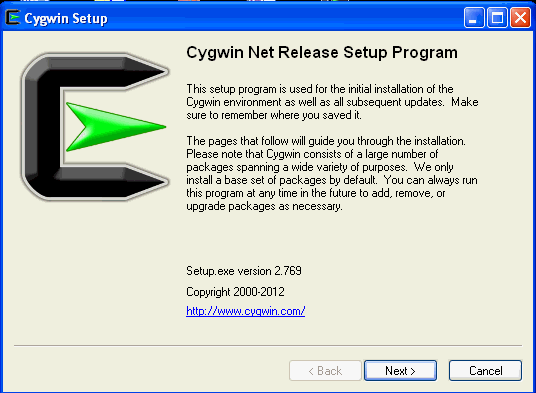
On the Choose Installation Type screen, select Install from Internet, then click Next.
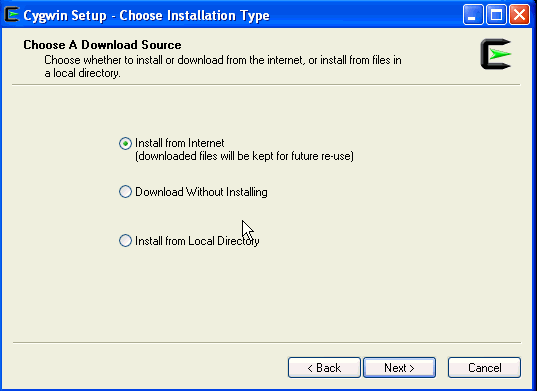
On the Choose Installation Directory screen, enter C:\cygwin as the Root Directory, then click Next.
Note:
If you choose to install Cygwin in a different directory, then ensure that you update theSSH_PATH, SCP_PATH, MKDIR_PATH, SH_PATH, CHMOD_PATH, and TRUE properties present in the $<OMS_HOME>\oui\prov\resources\ssPaths_msplats.properties file to their proper Cygwin binary values, after installing the Enterprise Manager system. For example, if you choose to install Cygwin in the D:\software\cygwin directory, then update the specified properties in the following manner:
SCP_PATH=D:\software\cygwin\bin\scp.exe SH_PATH=D:\software\cygwin\bin\sh.exe CHMOD_PATH=D:\software\cygwin\bin\chmod.exe LS_PATH=D:\software\cygwin\bin\ls.exe
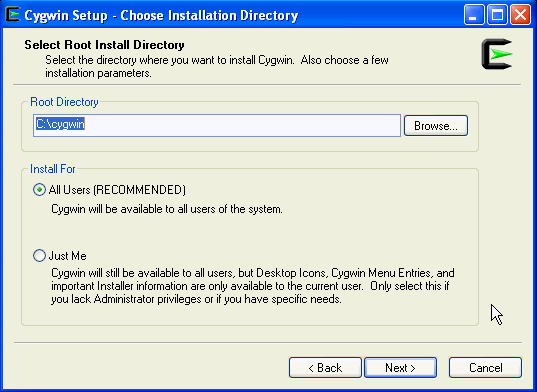
On the Select Local Package Directory screen, select a directory on your local machine where you want to store the downloaded installation files, then click Next.
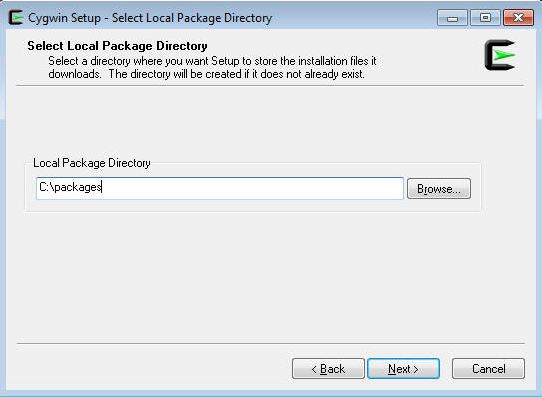
On the Select Connection Type screen, select appropriate settings to connect to the internet, then click Next.
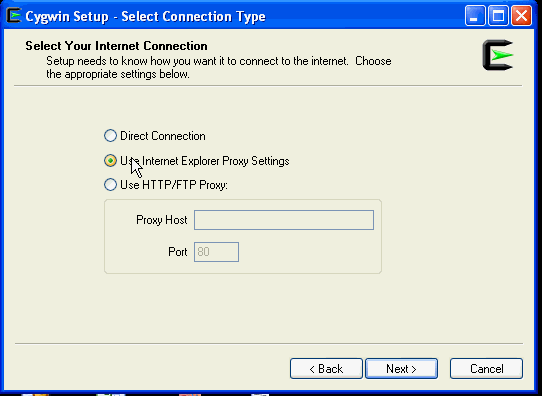
On the Choose Download Site(s) screen, select any site from the available list, then click Next.
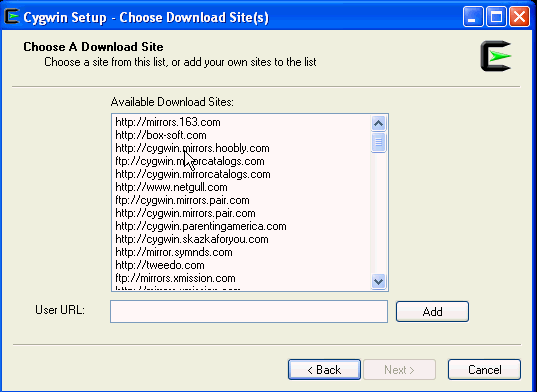
On the select packages screen, ensure that you select the following packages, then click Next:
From the Archive category, select unzip and zip as follows:

From the Net category, select openssh and openssl as follows:

After selecting the packages and clicking Next, the Resolving Dependencies screen is displayed. Click Next to proceed.

On the Installation Status and Create Icons screen, do not make any changes. Click Finish to complete the installation process.
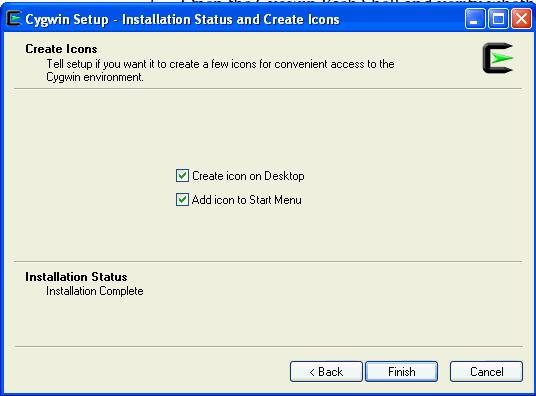
Configuring SSH
This section describes how to configure SSH and test your Cygwin setup after installing Cygwin on a host.
Note:
While configuring SSH, you may need to run thecygwin.bat script. While running cygwin.bat in Microsoft Windows Server 2008 and Microsoft Windows Vista, ensure that you invoke it in administrator mode. To do this, right-click the cygwin.bat file and select Run as administrator.To configure SSH and test your Cygwin setup, follow these steps:
-
After you install Cygwin, navigate to the
C:\cygwindirectory, open theCygwin.batfile in edit mode using any editor, and add the following line before invoking the bash shell.set CYGWIN=binmode ntsecFor example, here are the contents for the
Cygwin.batfile after adding the above line:@echo off C: chdir C:\cygwin\bin set CYGWIN=binmode ntsec bash --login -i -
To verify if Cygwin (
cygrunsrv)is installed properly, runC:\cygwin\Cygwin.bat, and execute the following command:cygrunsrv -h
If Cygwin is installed properly, then all the Cygwin help options are displayed on the screen. However, if this command returns an error message, then you may have to reinstall Cygwin.
-
To configure the SSHD service, run
C:\cygwin\Cygwin.bat, and execute the following command:ssh-host-config
After running the command, you are prompted the following questions:
*** Query: Should privilege separation be used? <yes/no>: yes *** Query: New local account 'sshd'? <yes/no>: yes *** Query: Do you want to install sshd as a service? *** Query: <Say "no" if it is already installed as a service> <yes/no>: yes *** Query: Enter the value of CYGWIN for the deamon: [] binmode ntsec *** Query: Do you want to use a different name? (yes/no) yes/no
At this point, if you want to use the same name, that is
cyg_server,enterno.You are then prompted the following questions:*** Query: Create new privileged user account 'cyg_server'? (yes/no) yes *** Query: Please enter the password: *** Query: Renter:However, if you want to use a different name, enter
yes.You are then prompted the following questions:*** Query: Enter the new user name: cyg_server1 *** Query: Reenter: cyg_server1 *** Query: Create new privileged user account 'cyg_server1'? (yes/no) yes *** Query: Please enter the password: *** Query: Reenter:If the configuration is successful, you will see the following message:
Host configuration finished. Have fun!
-
Backup the
c:\cygwin\etc\passwdfile and then use any editor to open the file in edit mode. Remove only those entries of the user that you will use to connect to the host on which you want to install a Management Agent. Ask the user to make a backup of thec:\cygwin\etc\passwdfile before editing.-
If the user that you are employing to connect to the host on which you want to install the Management Agent is a local user, run
C:\cygwin\Cygwin.batand execute the following:/bin/mkpasswd -l –u <USER> >> /etc/passwd (for example, /bin/mkpasswd -l -u pjohn >> /etc/passwd)
-
If the user you are employing to connect to the host on which you want to install the Management Agent running is a domain user, run
C:\cygwin\Cygwin.batand execute the following:/bin/mkpasswd -d -u <USER> >> /etc/passwd (for example, /bin/mkpasswd -d -u pjohn >> /etc/passwd) mkdir -p /home/<USER> (for example, mkdir -p /home/pjohn) chown <USER> /home/<USER> (for example, chown pjohn /home/pjohn)
-
-
(Only if the Cygwin software you have installed is of version 1.7.32 or higher) Open
C:\cygwin\etc\sshd_configin a text editor and add the following line to the end of the file:KexAlgorithms diffie-hellman-group-exchange-sha1,diffie-hellman-group1-sha1 -
(For a domain user only) If the user you are employing to connect to the host on which you want to install the Management Agent is a domain user, do the following to start the SSH daemon:
-
Right-click on My Computer, and select Manage.
-
In the Computer Management dialog box that appears, go to Services and Applications, and select CYGWIN sshd.
-
Right-click CYGWIN sshd and select Properties.
-
In the Properties dialog box, go to the Log On tab.
-
Here, specify the domain/user name and password. Click Apply.
-
Run
C:\cygwin\Cygwin.bat, and execute the following:chown <USERNAME> /var/log/sshd.log chown -R <USERNAME> /var/empty chown <USERNAME> /etc/ssh* chmod 755 /var/empty chmod 644 /var/log/sshd.log
Note:
If/var/log/sshd.logdoes not exist, you do not have to execute the following commands:chown <USERNAME> /var/log/sshd.log chmod 644 /var/log/sshd.log
-
-
Perform one of the following steps to start the SSH daemon:
Run
C:\cygwin\Cygwin.batand execute the following command:/usr/sbin/sshdOR
Run
C:\cygwin\Cygwin.batand execute the following command:cygrunsrv -S sshdOR
Perform these steps:
-
Right-click on My Computer, and select Manage.
-
In the Computer Management dialog box that appears, go to Services and Applications, and select CYGWIN sshd.
-
Click CYGWIN sshd, then click the Start button.
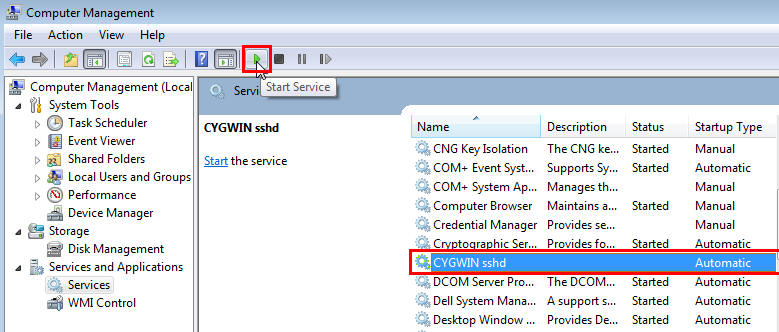
Note:
If the SSH daemon does not start up, view thec:\cygwin\var\log\sshd.logfile for information on why the start up failed. -
-
You can now test your Cygwin setup.
To do this, go to a different machine (that has the
sshclient running), and execute the following command:ssh -l <USERNAME> <localhost> 'date' OR ssh -l <USERNAME> <this node> 'date'
For example,
ssh -l pjohn example.com 'date'
This command will prompt you to specify the password. When you specify the correct password, the command should return the accurate date.
Note:
If you experience a process fork failure, memory leak error, or a file access error after configuring SSH, view the following website for a workaround:If you are unable to find a workaround for your problem, report your problem to the Cygwin community using the following website:
http://cygwin.com/problems.html
After Installing Cygwin and Configuring SSH
After installing Cygwin (as described in Section 5.3) and configuring SSH (as described in Section 5.4), follow these steps:
-
If the OMS host runs on a Microsoft Windows platform, perform the following on the OMS host:
-
Right click My Computer, then select Properties. In the window that appears, select Advanced system settings, then select Environment Variables. In the System Variables section, create the
CYGWINvariable, and specify its value asnodosfilewarningNote:
You do not need to restart the host after performing this step. -
Navigate to the Cygwin install directory (that is,
C:\cygwinif you chose to install Cygwin in the default location), open theCygwin.batfile in edit mode using any editor, then edit the following line:set CYGWIN=binmode ntsec nodosfilewarningFor example, these are the contents of the
Cygwin.batfile after editing the above line:@echo off C: chdir C:\cygwin\bin set CYGWIN=binmode ntsec nodosfilewarning bash --login -i
-
From the Start menu, select Run. For Open, enter
services.msc,then click OK. Search for the Cygwin SSHD service and stop it. -
Navigate to the Cygwin install directory (that is,
C:\cygwinif you chose to install Cygwin in the default location), then runCygwin.bat.Run the following command to start the SSHD service:$ /usr/sbin/sshd
Note:
Running this command may return an error mentioning that/var/emptymust be owned by the root user. If you encounter this error, run the following from the Cygwin terminal:$ chown <windows_install_user>:<windows_install_group> /var/empty
After running this command, retry the
$ /usr/sbin/sshdcommand.
-
-
Perform the tasks mentioned in Step 1 on all the Microsoft Windows target hosts (on which you want to install Management Agents using the Add Host Targets Wizard or EM CLI).